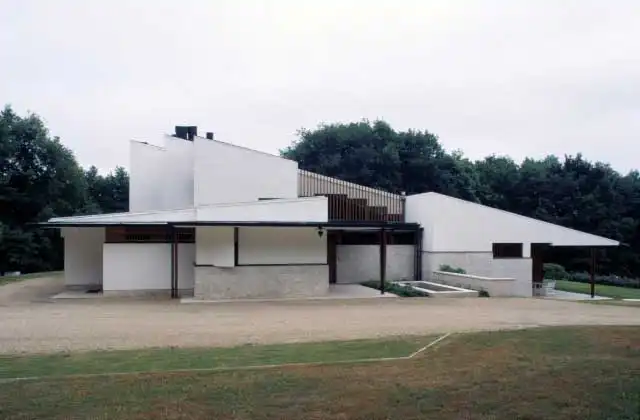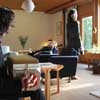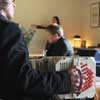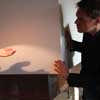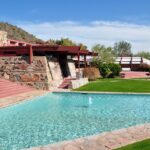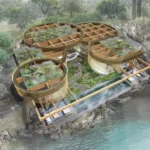Maison Louis Carré France, Alvar Aalto French house photos, 20C building design architect
Maison Louis Carré, France
French Alvar Aalto Architecture: Modern home by celebrated Modern Finnish Architect
post updated 20 April 2025
Architect: Alvar Aalto
Dates built: 1956-1959/63
Location: Bazoches-sur-Guyonne, Yvelines department, north-central France
View of the stairs on the south side:
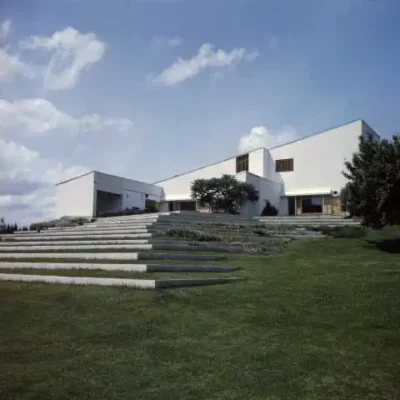
photograph © Collection Maison Louis Carré
9 Aug 2019
Maison Louis Carré
In June 1959, the French art dealer and collector Louis Carré moved with his third wife Olga into the house designed by Alvar Aalto in Bazoches-sur-Guyonne, some 40 km southwest of Paris. Combining architecture, furniture and landscape, Maison Louis Carré is the architect’s only remaining building in France and one of his most remarkable private houses.
The Encounter
Louis Carré and Alvar Aalto had met three years earlier at the Venice Biennale in the summer of 1956, where Aalto opened his Finnish Pavilion. The architect, in the full maturity of his art, and the successful gallerist, respected defender of modern art, immediately got along well together. They were of the same generation and, as Carré put it himself, they had “both a rather universal idea of art” (interview with Irmelin Lebeer, 1967, published partially in Galerie Louis Carré. Histoire et Actualité 2000).
In 1955, the gallerist had purchased 21 farmland plots in Bazoches, opposite his friend Jean Monnet’s estate, with the intention to build a residence where he could both live as well as put his collection on display. At the outset, he thought of Le Corbusier, with whom he was well acquainted, but as he was afraid of Le Corbusier’s preferences for concrete he chose rather to write to Aalto of whom he had heard from artists and gallery-owner friends.
View of the north facade:
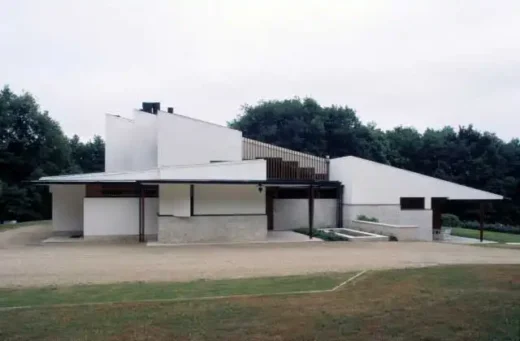
photograph © Martti Karpanen, Alvar Aalto Museum
After this Venetian meeting, Louis Carré went to Finland during the summer of 1956, where he visited the Villa Mairea and other buildings by Aalto, after which Alvar and Elissa Aalto came to France to visit the site. The site slopes gently and it is located on the border of the Rambouillet forest, between Versailles and Chartres. The building spot was decided on, as well as the form of the roof. Carré did not want a flat roof, and Aalto agreed that a sloped roof would blend in better with the landscape. Other than this, the architect had almost free reign.
The Architecture
In autumn 1957, the final plans were complete and the construction began. Elissa Aalto (1922-1994), the architect’s second wife, headed the project and spent long periods of time in France. Alvar Aalto also visited the site regularly. Marcel Roux Architects were in charge of the construction at the French end. Having participated in the designing process in Finland, the Swiss architect Marlaine Perrochet oversaw the construction on-site, the interior arrangements in particular.
The entrance hall in the early 1960s, works by Fernand Léger and Henri Laurens:
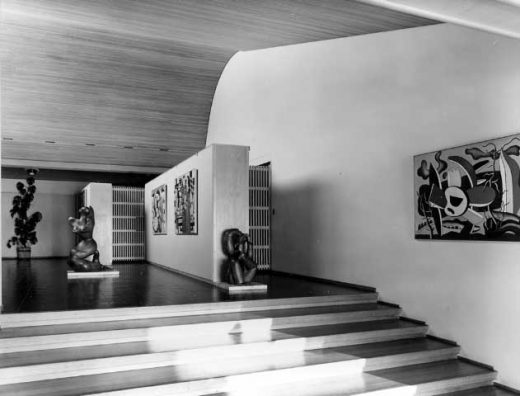
photograph © Alvar Aalto Museum
Upon arrival at the entrance gate – designed by Aalto in white brick and copper – the house is not yet visible. It unveils itself gradually, through the trees in the park, after a bend in the path that leads up to the house. The exterior materials are carefully chosen since Carré wanted elegant materials that would age well: limestone from Chartres and lime-washed bricks for the walls, blue slate from Normandy for the big roof, wood slates – either teak or ash – to punctuate the openings in the facades, copper for the gutters, edges of the walls, lamps and outside pillars.
Situated on the top of an area of 3 hectares, the building softly accommodates the slope. The ground floor centers on the entrance hall and can be divided into three main zones: the “public” area (hall, living room, library, dining room), the “private” area (a sauna and three bedrooms with en-suite bathrooms), and the “service” area (kitchen, pantry, staff dining room). On the first floor, there are servant’s bedrooms and a linen room, and the basement includes a boiler room and a wine cellar. Compared to the Villa Mairea, the house is not very big (350 m2 on the ground floor, 90 m2 on the first floor), but it boasts remarkable qualities of space and organization.
The main entrance is situated on the north side of the building, the kitchen and the service areas on the east. The living room and the library face west with a view of the garden and the surrounding landscape; the bedrooms and the bathrooms face south. Each important room also has its own external space: the living room and the library open onto a terrace and the lawn, the bedrooms and the bathrooms onto private terraces sheltered by brick and wooden walls. These terraces are invisible from the access path as well as from the rest of the garden, due to the perspective cut that the turf stairs create. This provides the occupant with complete privacy – one example of Aalto’s constant attention to the comfort of those who use his buildings.
A House for Art
Louis Carré said he wanted “a house that was small on the outside and big on the inside“ (interview, op. cit.). When entering the main hall, the wooden vault creates a striking effect towering first at 5metres before bowing softly towards the steps that lead to the living room. This ceiling is the only free-form element and it creates a sense of width and space throughout the entire house.
The lighting, both natural and artificial, comes from both the skylights above the main door as well as from three big, hanging lamps, which all emphasize this feeling of clear and generous space. It is reminiscent of a museum or of certain churches built by the architect during the same period (see the Church of the Three Crosses in Imatra in Eastern Finland).
The living room in 1960
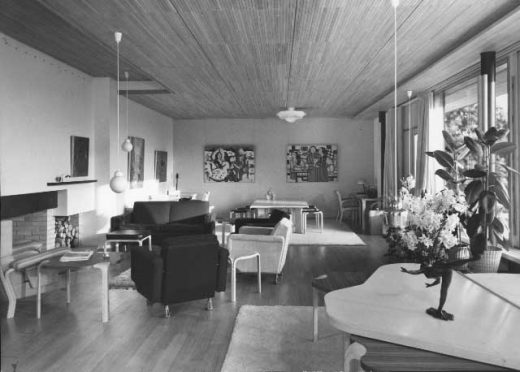
photograph © Heikki Havas, Alvar Aalto Museum
In this temple of modern art, everything aims to set off the owner’s art collection: walls covered with white painted canvases, a meticulous hanging system and lamps designed specifically to light up the walls, such as the ceiling lamp in the living room and the free-form hanging lamps in the dining room. Paintings by Fernand Léger, Pierre Bonnard, Pablo Picasso, Raoul Dufy, Jacques Villon, André Lanskoy, Nicolas de Staël and Paul Klee, sculptures by Henri Laurens, Alexander Calder and Alberto Giacometti as well as African art, all find ideal exhibition conditions here.
As on the outside, the inside materials have been carefully chosen: Finnish red pine for the ceilings of the hall and the living room (laid by Finnish craftspeople), oak for the parquets and the library shelves, ash and teak for the doors, the pillars and the fittings, bronze and leather for the door handles. Much of the furniture, lamps and textiles were designed specially for the villa, other pieces were chosen from the Artek catalogues (the company founded in 1935 to manufacture and spread Aalto’s design). The entire creation aims towards a feeling of discrete comfort and luxury.
Alvar Aalto also created the outdoors environment: the access path, the garage and the garden, made of free-form lawns, a small wood intended for receptions, asymmetrical steps and a small amphitheatre. At the outset, there was even a small vineyard close to the house which now is gone. After the Carrés moved in, Aalto kept adding elements such as outside lamps, flagpoles and above all the swimming pool and the pool house, completed in 1963.
Maison Louis Carré can easily be compared to Aalto’s other big residence, the Villa Mairea, built in Noormarkku in Finland some twenty years earlier, in 1938-39. Both houses were commissioned by wealthy patrons of art who encouraged their architect to give his all. Whereas the Finnish villa was an experimental work that underwent numerous changes during the construction process, Maison Carré is a work of maturity with great structural, stylistic and material consistency. From the first sketches in 1956 until completion in 1959, the plan and the interior design underwent only few modifications.
During the construction process, Louis Carré went to Finland several times, notably to choose the furniture at Artek. The gallerist was highly involved in the interior arrangements, searching for the right type of tiles or floor covering. He wrote numerous letters discussing details, small or big. In March 1958, in a letter from New York, he says that he has “already visited a number of friend’s bathrooms with a tape meter in [his] pocket“.
Alvar Aalto talked about the “personal collaboration, in the strictest sense, (…) necessary in order to allow the bases of an architectural whole to emerge.“ (letter to Will Grohmann, 10.8.1966, Archives nationales, Paris). More than a collaborator, Louis Carré was a firm and passionate patron who did not hesitate to dismiss the contractors that did not respect scrupulously his architect’s indications. He was conscious enough of the value of the house as a global work of art not to bring any of his previous furniture to the house, leaving the global design of the interiors to Alvar and Elissa Aalto. This is extraordinary for a man over 60 who used to be an antique dealer and collector.
The result is a unique villa, the fruit of an encounter between two exceptional personalities of two cultures. The building perfectly integrates the spatial and formal qualities that are characteristic of Alvar Aalto to the French landscape and its owner’s lifestyle. Compared to Aalto’s Finnish villas, Maison Carré has a “French touch” in the protecting character of its roof and blinds, the intimacy of its spaces as well as the warmth of its materials. Quoting the Finnish architect: “The generous preparation of the land opened up incredible possibilities and allowed an unprecedented freedom to create the architectural whole: the house and the landscape together in one unique design“ (letter to W. Grohmann, op.cit.).
Actual State
Louis Carré lived in his house until he died in 1977. In his lifetime, many important guests called in at Bazoches: artists such as Marcel Duchamp and Juan Miro, writers such as Paul Eluard, Jean Paulhan and Marcel Arland, friends such as Madeleine Renaud and Jean-Louis Barrault, politicians such as the Finnish president Urho Kekkonen… The yearly garden parties drew several hundred guests to the villa. After her husband’s death, Olga Carré stayed in the house, surrounded by paintings and sculpture, until she passed away in 2002. As they did not have children, her family inherited the house and the artworks. The latter were sold in an auction by the end of the year (Succession Olga Carré, née Burel, ancienne collection Louis Carré, Artcurial, 9 December 2002).
The dining room, paintings by André Lanskoy
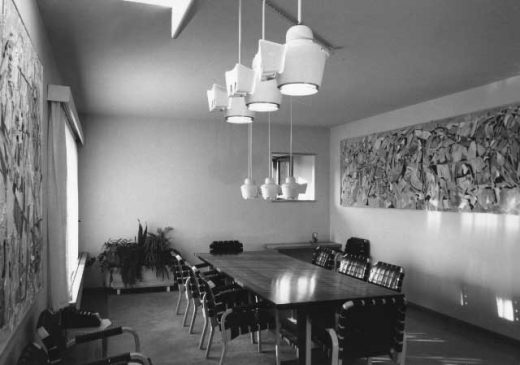
photograph © Heikki Havas, Alvar Aalto Museum
The house, listed “Monument historique” in 1996, was purchased by the Association Alvar Aalto en France in April 2006. Its purpose is: “The purchase and administration of the Maison Louis Carré at Bazoches-sur-Guyonne in view of promoting public interest and culture as well as the history and work if its Finnish architect Alvar Aalto“. The members of the Board are: Mr. Paavo Lipponen, Chair (former Prime Minister and Speaker of the Finnish Parliament), Mr. Markku Lahti, Vice-Chair (Director of the Aalto Foundation and the Alvar Aalto Museum), Mr. Tapani Manninen, Treasurer and Lawyer in Helsinki, Mr. Paul Lassus, Secretary and Lawyer in Paris, Mr. Vilhelm Helander, Head of Restoration Committee and Professor of Architecture History. The Seminar Committee is chaired by Mr. Esa Laaksonen, Director of the Aalto Academy in Helsinki.
Since the Maison Louis Carré has always been inhabited, its interior is well preserved and, remarkably enough, so is the major part of its furniture and fittings. The exterior had suffered more because of lack of maintenance during these last years. The restoration of the fences, the roof, the gutters, the chimneys, the access path, part of the indoor painting, the outdoor painting and woodwork has been completed during 2007-2008. The schedule in the years to come includes the restoration of the swimming pool and the pool house, the garage and the garden. The Association has received support from the Finnish Cultural Foundation, the Finnish Ministry of Education and Culture, the French Ministry of Culture and private sponsors.
Since August 2007, the Maison Louis Carré has been open to the public on weekends for guided tours with a winter closing 1st December-1st March. Thus the public has access to the building for the first time since its construction. In this manner, the Association wishes to make this major building of the Finnish master known, as well as the life and work of Louis Carré, both to professionals as well as to the general public. International seminars on architecture and design will be organized in what remains an exceptional testimony of civil architecture in the second half of the 20th century.
Released in 2008:
Alvar Aalto Architect. Maison Louis Carré
1956-63
by Esa Laaksonen and Asdis Olafsdottir, ed.
Alvar Aalto Academy, Helsinki (in English)
A French edition was published in Spring 2009
Lamp and the vault of the hall:
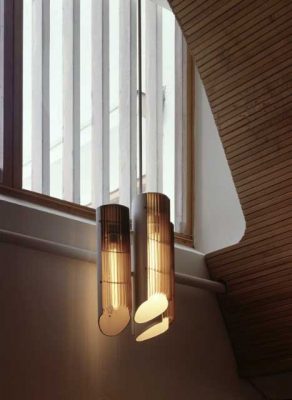
photograph © Maija Holma, Alvar Aalto Museum
Chronology and facts
1955 Louis Carré buys the land in Bazoches-sur-Guyonne, opposite the house of his friend Jean Monnet. First correspondence with Alvar Aalto.
1956 Summer: they meet at the Venice Biennale. Louis Carré goes to Finland, Alvar and Elissa Aalto come to France to see the site.
December: planning permission submitted.
1957 Autumn: construction begins.
1959 June: Louis and Olga Carré move into the house.
1961 October: plans of the swimming pool.
1962 October: visit of Finnish President Urho Kekkonen.
November: construction of the pool starts.
1963 Summer: swimming pool and pool house completed.
1977 Louis Carré dies, his widow Olga inherits the house and the artworks it contains. His grandsons inherit the gallery and part of the collection.
1996 The house, the garage, the swimming pool, the garden and the entrance gate are listed as “Monument historique”.
2002 Olga Carré dies, her heirs are her family.
December: auction of the artworks of the house at Artcurial, Paris.
2006 April: the house is purchased by the Association Alvar Aalto en France.
2007 Restoration work starts, with the support from the Finnish Cultural Foundation, the Finnish Ministry of Education and Culture and the French Ministry of Culture.
August: opening to the public on weekends.
26 September: first seminar and official opening of the house.
Surface of the house: 350 m2 on the ground floor, 90 m2 on the first floor
Surface of the garden: 3 hectars, 4 hectars with the surrounding land
Biographical notes
Alvar Aalto (1898-1976)
In the middle of the 1950s, at the moment of his encounter with Louis Carré, Alvar Aalto had already designed several major buildings in Finland, such as the Paimio Sanatorium, the Viipuri Library, the Villa Mairea, the National Pensions Institute in Helsinki, the Säynätsalo Town Hall and the House of Culture in Helsinki. His international fame was growing, although he had not yet built much abroad, except for the MIT Dormitory in Cambridge, USA (1947-48) and an apartment building close to Berlin (1955-57).
In France, his Finnish pavilion had attracted attention at the International Exhibition in 1937, where he had become friends with members of the Parisian art circles, such as Christian Zervos who published several articles on him in his magazine Cahiers d’art. As the pavilion was demolished, there were no buildings by Aalto left in France.
Louis Carré (1897-1977)
Of Brittany origin, Louis Carré was a lawyer at the Rennes Court before taking over the family business of antiquities. In 1928, he published Les poinçons dans l’orfèvrerie française (Le Grand Carré), devoted to hallmarks in old French plate, which is still an authority in that field. In the beginning of the 1930s, he discovered primitive art and then went into modern art. In 1934, he met Le Corbusier and moved to live in his Paris building in 24 rue Nungesser et Coli.
He exhibited works of Le Corbusier, among others, in the modern art gallery he opened with Roland Balaÿ at 10 avenue de Messine in Paris in 1938. He was mobilized the year after and founded the Galerie Louis Carré at the same address in 1940. The gallery stayed open during the war, presenting Dufy, Matisse, Rouault, Vuillard and Jacques Villon, among others. After the war, he defended Bazaine, Estève and Léger, for example, and opened a gallery in New York. Elissa Aalto, born
Elsa Kaisa Mäkiniemi (1922-1994)
This Finnish architect started to work in the Alvar Aalto office in 1949 and married her patron in 1952. She participated actively in the design of Maison Louis Carré, was head of project and stayed for long periods in France during the construction. After her husband’s death, she run the Aalto Studio, completing works such as the Essen Opera in Germany.
Olga Carré, born Burel (1910-2002)
Of a humble family from Brittany, Olga Burel was the companion of the French collector Robert Azaria. When he died in 1946, she inherited his art collection and contacted Louis Carré in order to sell some of the artworks. She became his housekeeper and then shared the adventure of the construction of the Maison Carré. They got married in February 1960.
Louis Carré and Alvar Aalto during the construction:
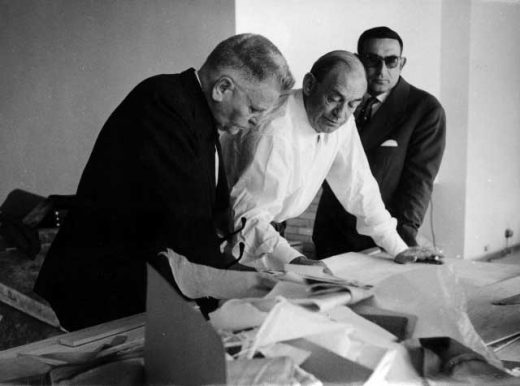
photograph © Alvar Aalto Museum
Maison Louis Carré images / information from Alvar Aalto Museum – Maison Louis Carré
Maison Louis Carré architect : Alvar Aalto
20 Sep 2011
Maison Louis Carré Seminar
This event took place at the famous Modern French house by Finnish architect Alvar Aalto
This week e-architect attended the seminar on “the 20th century house as a museum in France and Finland” organised by Asdis Olafsdottir and her team at the Maison Louis Carré (Alva Aalto). The event united prominent architects and conservators from France and Finland to give talks on the preservation and museumification of 20th century modern buildings.
The talks included a presentation of the current restoration of the Eileen Gray house at Roquebrune, an interesting talk shedding a somewhat dubious light on Corb’s intentions while designing the Villa Savoye and finally a warm and thoughtful presentation of the four Alvar Aalto buildings owned and run by the Alvar Aalto Museum in Helsinki.
The event ended with a inspiring performance by Eve Girardot and company encouraging the participants to think outside of the box when opening their buildings to the public.
Rebecca Breun, Head of Business Development for e-architect, based in Paris
Date: 19 Sep 2011 10.00 – 17.00
Venues: Maison Louis Carré + Maison de Jean Monnet
Organiser: Association Alvar Aalto en France
Address: Maison Louis Carré, 2 chemin du Saint Sacrement, 78490 Bazoches-sur-Guyonne
Speakers
Jean-Pierre Blanc, Director, Villa Noailles, Hyères
Stéphanie Celle, Conservator, Monuments nationaux
Maria Didrichsen, Chief Curator, Didrichsen Art Museum, Helsinki
Cristina Fiordimela, Research Fellow, Politecnico de Milano
Bertrand-Pierre Galey, Deputy to the General Director of Heritage matters, Ministry of Culture, in charge of Architecture
Pierre-Antoine Gatier, Architecte en chef des Monuments historiques
Bertrand Lemoine, Director, in charge of Grand Paris project
Susanna Pettersson, Director, Alvar Aalto Foundation and Alvar Aalto Museum
Moderators
Gilles Ragot, Art historian
Asdis Olafsdottir, Administrator of Maison Louis Carré
8:30 departure by bus from Paris
12:30 lunch and visit of Maison Louis Carré
17:00 cocktail
18:30 return to Paris
Answers invitation@maisonlouiscarre.fr
With the support of:
French Ministry of Culture and Communication
Finnish Embassy in France
EPDC
Location: Bazoches-sur-Guyonne, France.
New Buildings in France
French Architectural Projects
French Architect Offices – design firm listings
Paris Architecture Tours by e-architect
French Buildings : A-K
French Building Designs : L-Z
French Houses
Maison at Bordeaux design by Architect Rem Koolhaas, OMA
Maison Louis Carré -Links
www.maisonlouiscarre.fr
www.alvaraalto.fi
New Architecture Designs in France
Contemporary Architecture in Paris – architectural selection below:
Campus CEA Paris-Saclay Neuroscience Institute, south of Paris
Groupe Scolaire Dunoyer de Segonzac, Antony, Hauts-de-Seine, southern suburbs of Paris, France
Comments / photos for the Maison Louis Carré design by Alvar Aalto Architect in France page welcome

